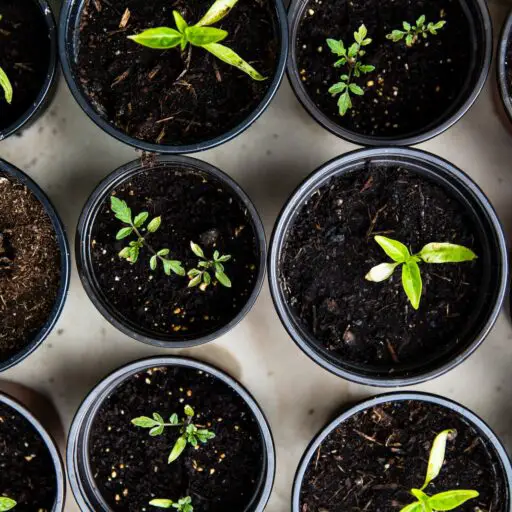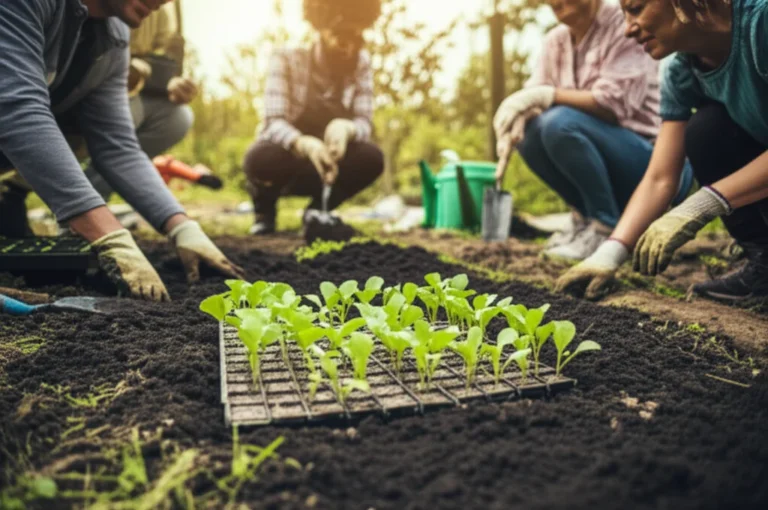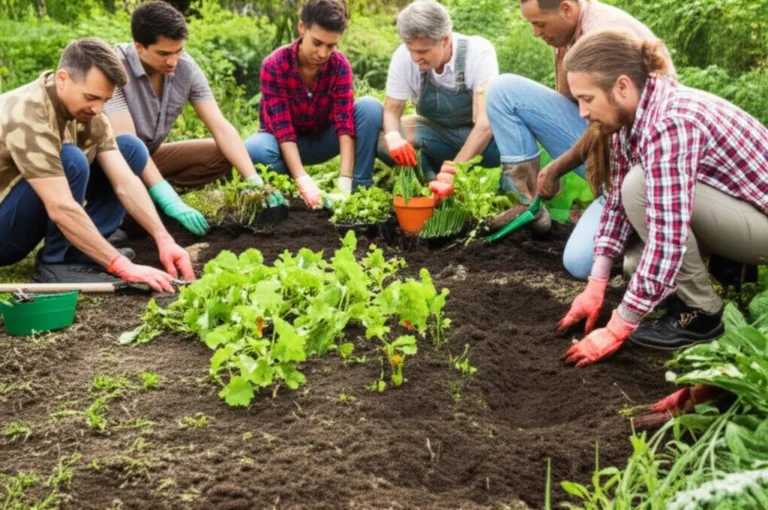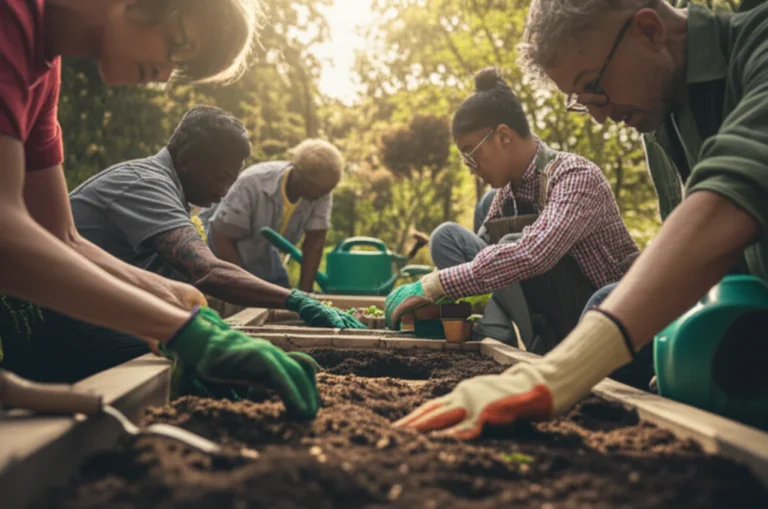Support our educational content for free when you purchase through links on our site. Learn more
Are you ready to dig into the world of community gardening? Imagine stepping into a vibrant green space filled with the sights and sounds of nature, where you can grow your own fresh produce while connecting with like-minded individuals. Community garden plots for rent are popping up everywhere, offering not just a chance to cultivate your green thumb but also to cultivate friendships and a sense of belonging. In this article, we’ll explore everything you need to know about renting a community garden plot, from the benefits and challenges to tips for maximizing your experience.
Did you know that community gardens can increase neighborhood engagement and improve mental health? 🌼 Join us as we uncover the top 10 community garden programs you should know about and the essential etiquette to follow in these shared spaces. You might just find your new favorite hobby—and a bountiful harvest—waiting for you!
Key Takeaways
- Community gardens provide fresh, organic produce and a sense of community for gardeners of all skill levels.
- Finding a plot is easier than you think! Utilize online resources, local networking, and community centers to discover available plots.
- Understanding garden rules is crucial for a harmonious gardening experience; be sure to follow guidelines regarding crop selection and maintenance.
- Maximize your gardening success by choosing the right crops, mastering watering techniques, and embracing organic practices.
- Engage with your community through shared resources, events, and friendships that blossom in the garden.
Ready to start your gardening journey? 👉 Shop gardening tools on:
Dive into the world of community gardening and watch your green dreams flourish! 🌿
Table of Contents
- Quick Tips and Facts
- Understanding Community Garden Plots for Rent
- Benefits of Renting a Community Garden Plot
- How to Find Community Garden Plots for Rent
- Top 10 Community Garden Programs You Should Know
- What to Consider When Renting a Garden Plot
- Community Gardening Etiquette: Do’s and Don’ts
- Tips for Maximizing Your Community Garden Experience
- Success Stories from Community Gardeners
- Challenges in Community Gardening and How to Overcome Them
- Innovative Ideas for Your Community Garden Plot
- Conclusion
- Recommended Links
- FAQ
- Reference Links
Quick Tips and Facts
🌱 Start Small: Don’t feel pressured to rent the biggest plot available. Begin with a size you can comfortably manage, especially as a beginner.
🌱 Location, Location, Location: Choose a plot with good sun exposure (at least 6 hours daily) and convenient access to water.
🌱 Community Matters: A strong community can enhance your gardening experience. Attend garden meetings and get to know your fellow gardeners.
🌱 Plan Ahead: Select crops suitable for your local climate and time your plantings accordingly.
🌱 Patience is Key: Gardening is a journey, not a race. Don’t get discouraged if things don’t go perfectly right away.
Understanding Community Garden Plots for Rent
Community garden plots for rent offer a fantastic opportunity to connect with nature, grow your own food, and become part of a vibrant community. Imagine this: you’re strolling through a lush green space, surrounded by the sights and smells of fresh herbs and colorful vegetables. This is the reality of community gardening! But what exactly are community garden plots for rent, and why are they becoming increasingly popular?
Defining Community Garden Plots
A community garden is a shared piece of land gardened collectively by a group of people. These gardens can vary in size, amenities, and management structure, but they all share the common goal of providing space for people to grow food and build community.
When you rent a community garden plot, you’re essentially leasing a designated area within this shared garden space. This plot becomes your own little piece of paradise where you can nurture your green thumb and cultivate a bounty of fresh produce.
Why Rent a Plot?
Renting a plot in a community garden offers numerous benefits over traditional backyard gardening, especially for those with limited space or resources. Here at Community Gardening™, we’ve seen firsthand how these gardens transform lives and neighborhoods.
For starters, community gardens provide access to land for those who might not have a yard or live in apartments. They also offer a supportive environment for novice gardeners to learn from more experienced growers. Plus, let’s not forget the social aspect! Community gardens are fantastic places to meet like-minded individuals, share gardening tips, and build lasting friendships.
Benefits of Renting a Community Garden Plot
Renting a community garden plot isn’t just about growing tomatoes and zucchini (although that’s a pretty great perk!). It’s about reaping a harvest of benefits that extend far beyond the garden gate. Let’s delve into some of the amazing advantages of joining a community garden:
1. Fresh, Healthy Food at Your Fingertips
Imagine stepping out your door and harvesting ingredients for a delicious salad or a flavorful stir-fry. Renting a community garden plot gives you the power to grow your own food, ensuring it’s fresh, healthy, and free from harmful pesticides. You’ll savor the flavors of your labor and appreciate the journey from seed to table.
2. Connecting with Nature and Your Community
In our increasingly urbanized world, it’s easy to feel disconnected from nature. Community gardens provide a much-needed oasis where you can reconnect with the earth, breathe in fresh air, and enjoy the therapeutic benefits of gardening. Plus, you’ll be surrounded by a supportive community of fellow gardeners who share your passion for growing. Check out our Community Garden Events page for exciting opportunities to engage with your local gardening community.
3. Sustainable Living and Environmental Benefits
By growing your own food, you’re reducing your carbon footprint and supporting a more sustainable lifestyle. Community gardens often promote eco-friendly practices like composting, water conservation, and organic gardening, minimizing your impact on the environment.
4. Physical and Mental Well-being
Gardening is a fantastic way to get some exercise, soak up vitamin D, and reduce stress. The act of planting, weeding, and harvesting can be incredibly therapeutic, promoting both physical and mental well-being.
How to Find Community Garden Plots for Rent
Ready to dig in and find your perfect community garden plot? The search might seem daunting at first, but fear not! We’re here to guide you through the process:
1. Online Resources
- Community Gardening Websites: Websites like the American Community Gardening Association (ACGA) often have directories or maps of community gardens in your area.
- Municipal Websites: Check your city or town’s website. Many municipalities have dedicated pages or departments for parks and recreation, which might include information about community gardens.
- Social Media: Join local gardening groups on Facebook or Nextdoor. These groups can be valuable resources for finding community gardens and connecting with other gardeners in your area.
2. Local Networking
- Garden Centers and Nurseries: Staff at local garden centers and nurseries are often plugged into the gardening community and can point you in the right direction.
- Community Centers and Libraries: Bulletin boards at community centers and libraries are often treasure troves of local information, including flyers or announcements about community gardens.
- Word of Mouth: Don’t underestimate the power of word of mouth! Ask friends, family, neighbors, and colleagues if they know of any community gardens in the area.
3. Contacting Garden Organizers
Once you’ve identified potential community gardens, reach out to the organizers. They can provide information about plot availability, rental fees, garden rules, and waiting lists.
Top 10 Community Garden Programs You Should Know
With the growing popularity of community gardening, numerous organizations and programs have emerged to support these green spaces. Here are ten notable community garden programs making a difference across the country:
- American Community Gardening Association (ACGA): The ACGA is a national organization dedicated to promoting and supporting community gardening. They offer resources, networking opportunities, and advocacy for community gardens nationwide.
- The Garden Project: This San Francisco-based program empowers people impacted by incarceration to rebuild their lives through urban farming and gardening.
- City Sprouts: This non-profit organization in Cambridge, MA, integrates school gardens into the curriculum, teaching children about food, the environment, and healthy eating.
- Growing Power: Founded by Will Allen, a MacArthur “Genius Grant” recipient, Growing Power is a national model for urban agriculture, promoting sustainable food systems and community development.
- The Edible Schoolyard Project: Inspired by Alice Waters, this program builds and supports edible gardens in schools, connecting children to the food they eat and fostering healthy eating habits.
- Ron Finley Project: Known as the “Gangster Gardener,” Ron Finley transforms food deserts in South Central Los Angeles by planting gardens in abandoned lots and parkways.
- Green City Growers: This Boston-based company designs, builds, and maintains productive urban farms and gardens for businesses, schools, and communities.
- Urban Harvest: This Houston-based non-profit organization promotes community gardening, farmers’ markets, and sustainable urban agriculture practices.
- Denver Urban Gardens (DUG): DUG supports a network of community gardens in Denver, providing resources, education, and advocacy for urban gardeners.
- Fairfax County Park Authority Community Garden Program: This program offers over 700 garden plots in ten county parks, providing ample opportunities for Fairfax County residents to engage in community gardening.
What to Consider When Renting a Garden Plot
Before you grab your gardening gloves and trowel, take some time to consider these essential factors when renting a community garden plot:
1. Plot Size and Layout
- How much space do you realistically need? Start small and gradually increase your plot size as your confidence and experience grow.
- Is the plot layout suitable for your needs? Consider factors like sun exposure, water access, and accessibility for tools and equipment.
2. Garden Rules and Regulations
- What are the garden’s rules regarding pesticides, herbicides, and fertilizers? Many community gardens prioritize organic gardening practices.
- Are there any restrictions on the types of plants you can grow? Some gardens might have guidelines regarding tall plants, invasive species, or crops that attract pests.
- What are the expectations for plot maintenance and upkeep? Community gardens typically require gardeners to keep their plots weed-free and well-maintained.
3. Community and Support
- Is there a strong sense of community among the gardeners? A supportive and welcoming community can enhance your gardening experience.
- Are there opportunities for shared resources, knowledge, and tools? Some community gardens have shared toolsheds, composting systems, or workshops for gardeners.
- What are the communication channels within the garden? Find out how information is shared, whether through email lists, bulletin boards, or in-person meetings.
Community Gardening Etiquette: Do’s and Don’ts
Community gardening is a rewarding experience, but it’s essential to be mindful of your fellow gardeners and the shared space. Here’s a handy guide to community garden etiquette:
Do’s:
- ✅ Respect Shared Resources: Conserve water, return shared tools promptly, and clean up after yourself.
- ✅ Be a Good Neighbor: Offer help to fellow gardeners, share extra produce, and be mindful of noise levels.
- ✅ Communicate Clearly: Label your plants, inform garden organizers of any issues, and be open to feedback.
- ✅ Follow Garden Rules: Adhere to the garden’s guidelines regarding pesticides, plot maintenance, and waste disposal.
- ✅ Have Fun! Enjoy the process of gardening, connect with nature, and celebrate your harvest with your community.
Don’ts:
- ❌ Don’t Use Harmful Chemicals: Avoid using synthetic pesticides, herbicides, or fertilizers that could harm beneficial insects or contaminate crops.
- ❌ Don’t Neglect Your Plot: Keep your plot weed-free, water your plants regularly, and harvest your produce promptly to prevent pests and diseases.
- ❌ Don’t Be a Space Hog: Stick to your designated plot and avoid encroaching on your neighbor’s space.
- ❌ Don’t Gossip or Spread Negativity: Foster a positive and supportive community by focusing on collaboration and encouragement.
- ❌ Don’t Be Afraid to Ask for Help: Gardening is a learning process. Don’t hesitate to seek advice from more experienced gardeners or garden organizers.
Tips for Maximizing Your Community Garden Experience
Ready to take your community gardening experience to the next level? Here are some insider tips from the experts at Community Gardening™:
1. Choose the Right Crops
- Select varieties that thrive in your local climate. Consider factors like sunlight, temperature, and rainfall.
- Start with easy-to-grow crops. Lettuce, radishes, beans, and zucchini are great options for beginners.
- Experiment with companion planting. Certain plants can benefit each other when grown together, deterring pests or improving growth. For instance, planting basil alongside tomatoes can enhance their flavor and repel insects.
2. Master the Art of Watering
- Water deeply and infrequently. This encourages strong root development and prevents shallow root systems.
- Water early in the morning or late in the evening. This minimizes evaporation and allows plants to absorb moisture effectively.
- Consider using a soaker hose or drip irrigation system. These methods deliver water directly to the roots, reducing water waste.
3. Embrace Organic Practices
- Build healthy soil by adding compost. Compost enriches the soil with nutrients, improves drainage, and promotes beneficial microbial activity.
- Mulch around your plants. Mulch helps retain moisture, suppress weeds, and regulate soil temperature.
- Attract beneficial insects. Plant flowers that attract pollinators and predatory insects that help control pests.
4. Document Your Journey
- Keep a gardening journal. Track your planting dates, weather conditions, successes, and challenges.
- Take photos of your garden’s progress. It’s amazing to look back and see how far your garden has come.
- Share your experiences with your community. Offer tips, exchange recipes, and celebrate your harvest with fellow gardeners.
Success Stories from Community Gardeners
At Community Gardening™, we’re constantly inspired by the incredible stories that emerge from community gardens across the country. Here are a few heartwarming examples:
- From Concrete to Carrots: A group of residents in a densely populated urban neighborhood transformed an abandoned lot into a thriving community garden, providing fresh produce and a sense of community to their neighborhood.
- Bridging Generations Through Gardening: A community garden became a place where senior citizens and young children connected through their shared love of gardening, sharing knowledge, stories, and laughter.
- Growing Food and Friendship: A community garden brought together people from diverse backgrounds, fostering friendships, cultural exchange, and a shared sense of purpose.
Challenges in Community Gardening and How to Overcome Them
While community gardening offers a plethora of benefits, it’s not without its challenges. Let’s explore some common obstacles and how to overcome them:
1. Pests and Diseases
- Prevention is Key: Choose disease-resistant varieties, rotate crops, and practice good garden hygiene to minimize pest and disease pressure.
- Natural Remedies: Utilize organic pest control methods like insecticidal soap, neem oil, or companion planting to deter pests.
- Seek Advice: Consult with local garden experts or experienced gardeners for guidance on identifying and managing pests and diseases.
2. Water Management
- Drought Conditions: Install a rain barrel to collect rainwater or explore water-wise gardening techniques like xeriscaping.
- Overwatering: Ensure proper soil drainage and avoid overwatering, which can lead to root rot and other problems.
- Shared Water Resources: Communicate with fellow gardeners about watering schedules and be mindful of shared water resources.
3. Theft or Vandalism
- Security Measures: Consider installing fences, locks, or security cameras to deter theft or vandalism.
- Community Watch: Encourage gardeners to report any suspicious activity and look out for each other’s plots.
- Insurance: Inquire about insurance options to protect your investment in case of theft or damage.
Innovative Ideas for Your Community Garden Plot
Looking for creative ways to enhance your community garden plot? Here are some innovative ideas to inspire you:
1. Vertical Gardening
Maximize space and create a visually stunning display by incorporating vertical gardening techniques. Use trellises, hanging planters, or living walls to grow vining crops like tomatoes, cucumbers, or beans.
2. Keyhole Gardens
Keyhole gardens are raised beds with a keyhole-shaped indentation that allows for easy access and efficient composting. The composting center provides nutrients to the surrounding plants, creating a self-sustaining system.
3. Hugelkultur Beds
Hugelkultur beds are raised beds built on top of decaying wood, mimicking the natural decomposition process in forests. The wood acts as a sponge, retaining moisture and releasing nutrients as it breaks down.
4. Sensory Gardens
Create a multi-sensory experience by incorporating plants with different textures, scents, and colors. Plant fragrant herbs like lavender, rosemary, and mint, alongside brightly colored flowers and textured foliage.
5. Pollinator Gardens
Attract bees, butterflies, and other beneficial insects by planting a diverse array of flowering plants. Choose native plants that provide nectar and pollen throughout the growing season. For more garden design ideas, visit our Garden Design Ideas page.
Remember, community gardening is a journey of learning, growth, and connection. Embrace the challenges, celebrate the successes, and enjoy the fruits (and vegetables!) of your labor. Happy gardening!
Conclusion

In conclusion, renting a community garden plot is an enriching experience that offers numerous benefits, from fresh produce to a sense of community. 🌿 Whether you’re a seasoned gardener or a curious beginner, these plots provide a unique opportunity to connect with nature, learn new skills, and foster relationships with fellow gardening enthusiasts.
Positives:
- Access to fresh, organic produce
- Opportunities for community engagement and learning
- Supportive environments for novice gardeners
- Sustainable living practices
Negatives:
- Potential challenges with pests and diseases
- Adherence to community rules and regulations
- Limited control over plot size and layout
Despite these challenges, the rewards of community gardening far outweigh the drawbacks. We confidently recommend that you explore local community gardens and consider renting a plot. You’ll not only cultivate plants but also friendships and memories that will last a lifetime! 🌼
Recommended Links
-
👉 Shop Gardening Tools on:
-
Books to Enhance Your Gardening Knowledge:
FAQ

What are the benefits of renting a community garden plot for beginners?
Renting a community garden plot offers beginners a hands-on learning experience in a supportive environment. Here are some key benefits:
1. Access to Resources and Knowledge
Community gardens often have experienced gardeners who can provide guidance and share tips. This mentorship can be invaluable for beginners looking to improve their gardening skills.
2. Reduced Financial Risk
Renting a plot allows beginners to test their gardening skills without the financial commitment of purchasing land or investing heavily in equipment.
3. Social Interaction
Community gardens foster a sense of belonging and provide opportunities to meet like-minded individuals. This social aspect can enhance the gardening experience and encourage collaboration.
How do I find a community garden with available plots for rent in my area?
Finding a community garden with available plots can be straightforward if you know where to look:
1. Online Directories
Check websites like the American Community Gardening Association (ACGA) or local municipal websites that often list community gardens and their contact information.
2. Social Media and Local Groups
Join local gardening groups on platforms like Facebook or Nextdoor, where members often share information about available plots and community gardening events.
3. Networking
Visit local garden centers or community centers and ask staff for recommendations. Word of mouth can also be a powerful tool; ask friends or neighbors if they know of any community gardens nearby.
Read more about “Do Community Gardens Save Money? 10 Surprising Benefits! 🌱”
What are the typical rules and regulations for community garden plot rentals?
While rules can vary by garden, here are some common regulations you might encounter:
1. Maintenance Responsibilities
Gardeners are usually required to keep their plots weed-free and well-maintained throughout the growing season.
2. Plant Restrictions
Some gardens may have guidelines on what types of plants can be grown, especially regarding invasive species or plants that attract pests.
3. Use of Chemicals
Many community gardens encourage organic gardening practices, so the use of synthetic pesticides and herbicides may be prohibited.
Can I grow any type of plant or crop in a community garden plot that I rent?
While you may have some flexibility, it’s essential to check the specific rules of your community garden. Here are some considerations:
1. Crop Selection
Most community gardens allow a variety of vegetables, herbs, and flowers. However, certain gardens may restrict the planting of large crops or invasive species.
2. Seasonal Planting
Consider the local climate and growing season when selecting crops. Some gardens may have guidelines on what can be planted during specific times of the year.
3. Communal Considerations
Be mindful of your neighbors; growing plants that may attract pests or require excessive space could impact the overall garden environment.
Reference Links
- American Community Gardening Association
- DPR Community Gardens
- Fairfax County Park Authority Community Garden Program
- OSU Extension Metro Area Master Gardener™ Program
By exploring these resources, you’ll be well on your way to becoming a successful community gardener. Happy planting! 🌻





